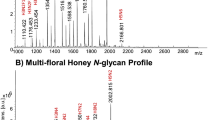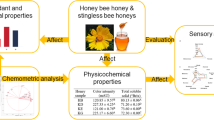Abstract
A study in order to differentiate Tempranillo and Tempranillo blanco grapes and wines from A.O.C. Rioja (Spain) has been carried out. The three most important groups of chemical compounds in grapes and wines were determined: nitrogen and phenolic compounds by HPLC–DAD, and volatile compounds by GC–MS. A machine learning approach was carried out to achieve the most important chemical parameters to differentiate Tempranillo and Tempranillo blanco grapes and wines based on the Kruskal–Wallis test, F-score feature selector, and support vector machine classification. Four importance levels were established for both grape and wine discrimination. The first level is composed of variables that can differentiate Tempranillo and Tempranillo blanco grapes and wines by analyzing the chemical concentrations. The second, third, and fourth level of importance is composed of a variable set that can correctly classify the samples, each one determined according to the F-score importance ranking and the SVM discriminations. Some chemical compounds demonstrated to be good predictors to wine and grape discriminations, whereas some chemicals are only a good predictor to one discrimination approach.





Similar content being viewed by others
Data Availability
Not applicable.
Code Availability
Not applicable.
References
Ayestarán B, Martìnez-Lapuente L, Guadalupe Z, Canals C, Adell E, Vilanova M (2019) Effect of the winemaking process on the volatile composition and aromatic profile of Tempranillo Blanco wines. Food Chem 276:187–194
Belmiro TMC, Pereira CF, Paim APS (2017) Red wines from South America: content of phenolic compounds and chemometric distinction by origin. Microchem J 133:114–120
Brereton RG, Jansen J, Lopes J, Marini F, Pomerantsev A, Rodionova O, … Tauler R (2018) Chemometrics in analytical chemistry—part II: modeling, validation, and applications. Anal Bioanal Chem 410(26):6691–6704.https://doi.org/10.1007/s00216-018-1283-4
Cabrera-Bañegil M, Valdés-Sánchez E, Muñoz-de la Peña A, Durán-Merás I (2019) Combination of fluorescence excitation emission matrices in polar and non-polar solvents to obtain three- and four- way arrays for classification of Tempranillo grapes according to maturation stage and hydric status. Talanta 199(December 2018):652–661
Callao MP, Ruisánchez I (2018) An overview of multivariate qualitative methods for food fraud detection. Food Control 86:283–293
Chandrashekar G, Sahin F (2014) A survey on feature selection methods. Comput Electr Eng 40(1):16–28
Chen Y-W, Lin C-J (2006) Combining SVMs with various feature selection strategies. In: Feature extraction (pp. 315–324). https://doi.org/10.1007/978-3-540-35488-8_13
Cortes C, Vapnik V (1995) Support-vector networks. Mach Learn 20(3):273–297
Costa NL, Llobodanin LAG, Castro IA, Barbosa R (2019) Using support vector machines and neural networks to classify Merlot wines from South America. Inf Process Agric 6(2):265–278. https://doi.org/10.1016/j.inpa.2018.10.003
Cynkar W, Dambergs R, Smith P, Cozzolino D (2010) Classification of Tempranillo wines according to geographic origin: combination of mass spectrometry based electronic nose and chemometrics. Anal Chim Acta 660(1–2):227–231
da Costa Nattane, Luiza Castro, I. A., & Barbosa, R. (2016) Classification of Cabernet Sauvignon from two different countries in South America by chemical compounds and support vector machines. Appl Artif Intell 30(7):679–689. https://doi.org/10.1080/08839514.2016.1214416
da Costa NL, Llobodanin LAG, Castro IA, Barbosa R (2019) The use of data mining to classify Carménère and Merlot wines from Chile. Expert Syst 36(2):e12361
Ganss S, Kirsch F, Winterhalter P, Fischer U, Schmarr H-G (2011) Aroma changes due to second fermentation and glycosylated precursors in Chardonnay and Riesling sparkling wines. J Agric Food Chem 59(6):2524–2533
Garde-Cerdán T, Ancín-Azpilicueta C (2008) Effect of the addition of different quantities of amino acids to nitrogen-deficient must on the formation of esters, alcohols, and acids during wine alcoholic fermentation. LWT-Food Sci Technol 41(3):501–510
Garde-Cerdán T, Lorenzo C, Lara JF, Pardo F, Ancín-Azpilicueta C, Salinas MR (2009) Study of the evolution of nitrogen compounds during grape ripening. Application to differentiate grape varieties and cultivated systems. J Agric Food Chem 57(6):2410–2419
Garde-Cerdán T, Martínez-Gil AM, Lorenzo C, Lara JF, Pardo F, Salinas MR (2011) Implications of nitrogen compounds during alcoholic fermentation from some grape varieties at different maturation stages and cultivation systems. Food Chem 124(1):106–116
Garde-Cerdán T, Gutiérrez-Gamboa G, Baroja E, Rubio-Bretón P, Pérez-Álvarez EP (2018) Influence of methyl jasmonate foliar application to vineyard on grape volatile composition over three consecutive vintages. Food Res Int 112:274–283
González-Lázaro M, Martínez-Lapuente L, Palacios A, Guadalupe Z, Ayestarán B, Bueno-Herrera M, de la Cuesta PL, Pérez-Magariño S (2019) Effects of different oenological techniques on the elaboration of adequate base wines for red sparkling wine production: phenolic composition, sensory properties and foam parameters. J Sci Food Agric 99(10):4580–4592
Gutiérrez-Gamboa G, Garde-Cerdán T, Martínez-Lapuente L, Souza-da Costa B, Rubio-Bretón P, Pérez-Álvarez EP (2020a) Phenolic composition of Tempranillo Blanco (Vitis vinifera L.) grapes and wines after biostimulation through a foliar seaweed application. J Sci Food Agric. https://doi.org/10.1002/jsfa.10094
Gutiérrez-Gamboa G, Garde-Cerdán T, Rubio-Bretón P, Pérez-Álvarez EP (2020b) Study of must and wine amino acids composition after seaweed applications to Tempranillo blanco grapevines. Food Chem. https://doi.org/10.1016/j.foodchem.2019.125605
Gutiérrez-Gamboa G, Garde-Cerdán T, Rubio-Bretón P, Pérez-Álvarez EP (2020c) Seaweed foliar applications at two dosages to Tempranillo blanco (Vitis vinifera L.) grapevines in two seasons: effects on grape and wine volatile c omposition. Food Res Int 130:108918
Hosu A, Cristea VM, Cimpoiu C (2014) Analysis of total phenolic, flavonoids, anthocyanins and tannins content in Romanian red wines: prediction of antioxidant activities and classification of wines using artificial neural networks. Food Chem 150:113–118. https://doi.org/10.1016/j.foodchem.2013.10.153
Hou X, Wang G, Su G, Wang X, Nie S (2019) Rapid identification of edible oil species using supervised support vector machine based on low-field nuclear magnetic resonance relaxation features. Food Chem 280(November 2018):139–145. https://doi.org/10.1016/j.foodchem.2018.12.031
Jaitz L, Siegl K, Eder R, Rak G, Abranko L, Koellensperger G, Hann S (2010) LC–MS/MS analysis of phenols for classification of red wine according to geographic origin, grape variety and vintage. Food Chem 122(1):366–372
Jiménez-Carvelo AM, González-Casado A, Bagur-González MG, Cuadros-Rodríguez L (2019) Alternative data mining/machine learning methods for the analytical evaluation of food quality and authenticity – a review. Food Res Int 122(March):25–39. https://doi.org/10.1016/j.foodres.2019.03.063
Jurado JM, Alcázar Á, Palacios-Morillo A, De Pablos F (2012) Classification of Spanish DO white wines according to their elemental profile by means of support vector machines. Food Chem 135(3):898–903. https://doi.org/10.1016/j.foodchem.2012.06.017
Kruzlicova D, Mocak J, Balla B, Petka J, Farkova M, Havel J (2009) Classification of Slovak white wines using artificial neural networks and discriminant techniques. Food Chem 112(4):1046–1052. https://doi.org/10.1016/j.foodchem.2008.06.047
Medina S, Perestrelo R, Silva P, Pereira JAM, Câmara JS (2019) Current trends and recent advances on food authenticity technologies and chemometric approaches. Trends Food Sci Technol 85(January):163–176. https://doi.org/10.1016/j.tifs.2019.01.017
Pérez-Álvarez EP, Garde-Cerdán T, García-Escudero E, Martínez-Vidaurre JM (2017) Effect of two doses of urea foliar application on leaves and grape nitrogen composition during two vintages. J Sci Food Agric 97(8):2524–2532
Pérez-Álvarez EP, Martìnez-Vidaurre JM, Garde-Cerdán T (2019) Anthocyanin composition of grapes from three different soil types in cv. Tempranillo AOC Rioja vineyards. J Sci Food Agric. https://doi.org/10.1002/jsfa.9741
Pisano PL, Silva MF, Olivieri AC (2015) Anthocyanins as markers for the classification of Argentinean wines according to botanical and geographical origin. Chemometric modeling of liquid chromatography-mass spectrometry data. Food Chem 175:174–180
Portu J, Santamaria P, Lopez-Alfaro I, Lopez R, Garde-Cerdan T (2015) Methyl jasmonate foliar application to Tempranillo vineyard improved grape and wine phenolic content. J Agric Food Chem 63(8):2328–2337
R Development Core Team, & R Core Team (2016) R: a language and environment for statistical computing. R Foundation for Statistical Computing Vienna Austria, Vol. 0. Retrieved from http://www.r-project.org/
Richter B, Gurk S, Wagner D, Bockmayr M, Fischer M (2019) Food authentication: multi-elemental analysis of white asparagus for provenance discrimination. Food Chem 286(January):475–482. https://doi.org/10.1016/j.foodchem.2019.01.105
Rubio-Bretón P, Gonzalo-Diago A, Iribarren M, Garde-Cerdán T, Pérez-Álvarez EP (2018) Bioprotection as a tool to free additives winemaking: Effect on sensorial, anthocyanic and aromatic profile of young red wines. LWT Food Sci Technol 98:458–464. https://doi.org/10.1016/j.lwt.2018.08.050
Rubio-Bretón P, Salinas MR, Nevares I, Pérez-Álvarez EP, del Álamo-Sanza M, Marín-San Román S, Alonso GL, Garde-Cerdán T (2020) Recent advances in the study of grape and wine volatile composition: varietal, fermentative, and aging aroma compounds. In: Bordiga M, Nollet LML (eds) Food aroma evolution: during food processing, cooking, and aging. CRC Press, Boca Raton, pp 439–464
Valentin L, Barroso LP, Barbosa RM, de Paulo GA, Castro IA (2020) Chemical typicality of South American red wines classified according to their volatile and phenolic compounds using multivariate analysis. Food Chem 302(May 2019):125340. https://doi.org/10.1016/j.foodchem.2019.125340
Zhang J, Li L, Gao N, Wang D, Gao Q, Jiang S (2010) Feature extraction and selection from volatile compounds for analytical classification of Chinese red wines from different varieties. Anal Chim Acta 662(2):137–142
Ziółkowska A, Wąsowicz E, Jeleń HH (2016) Differentiation of wines according to grape variety and geographical origin based on volatiles profiling using SPME-MS and SPME-GC/MS methods. Food Chem 213:714–720. https://doi.org/10.1016/j.foodchem.2016.06.120
Author information
Authors and Affiliations
Corresponding authors
Ethics declarations
Ethics Approval
Not applicable.
Informed Consent
Not applicable.
Conflict of Interest
T. Garde-Cerdán declares that she has no conflict of interest. N. L. da Costa declares that she has no conflict of interest. P. Rubio-Bretón declares that he has no conflict of interest. R. Barbosa declares that he has no conflict of interest. E. Baroja declares that he has no conflict of interest. J. M. Martínez-Vidaurre declares that he has no conflict of interest. S. Marín-San Román declares that he has no conflict of interest. I. Sáenz de Urturi declares that he has no conflict of interest. E. P. Pérez-Álvarez declares that he has no conflict of interest.
Additional information
Publisher’s Note
Springer Nature remains neutral with regard to jurisdictional claims in published maps and institutional affiliations.
Rights and permissions
About this article
Cite this article
Garde-Cerdán, T., da Costa, N.L., Rubio-Bretón, P. et al. The Most Important Parameters to Differentiate Tempranillo and Tempranillo Blanco Grapes and Wines through Machine Learning. Food Anal. Methods 14, 2221–2236 (2021). https://doi.org/10.1007/s12161-021-02049-6
Received:
Accepted:
Published:
Issue Date:
DOI: https://doi.org/10.1007/s12161-021-02049-6




